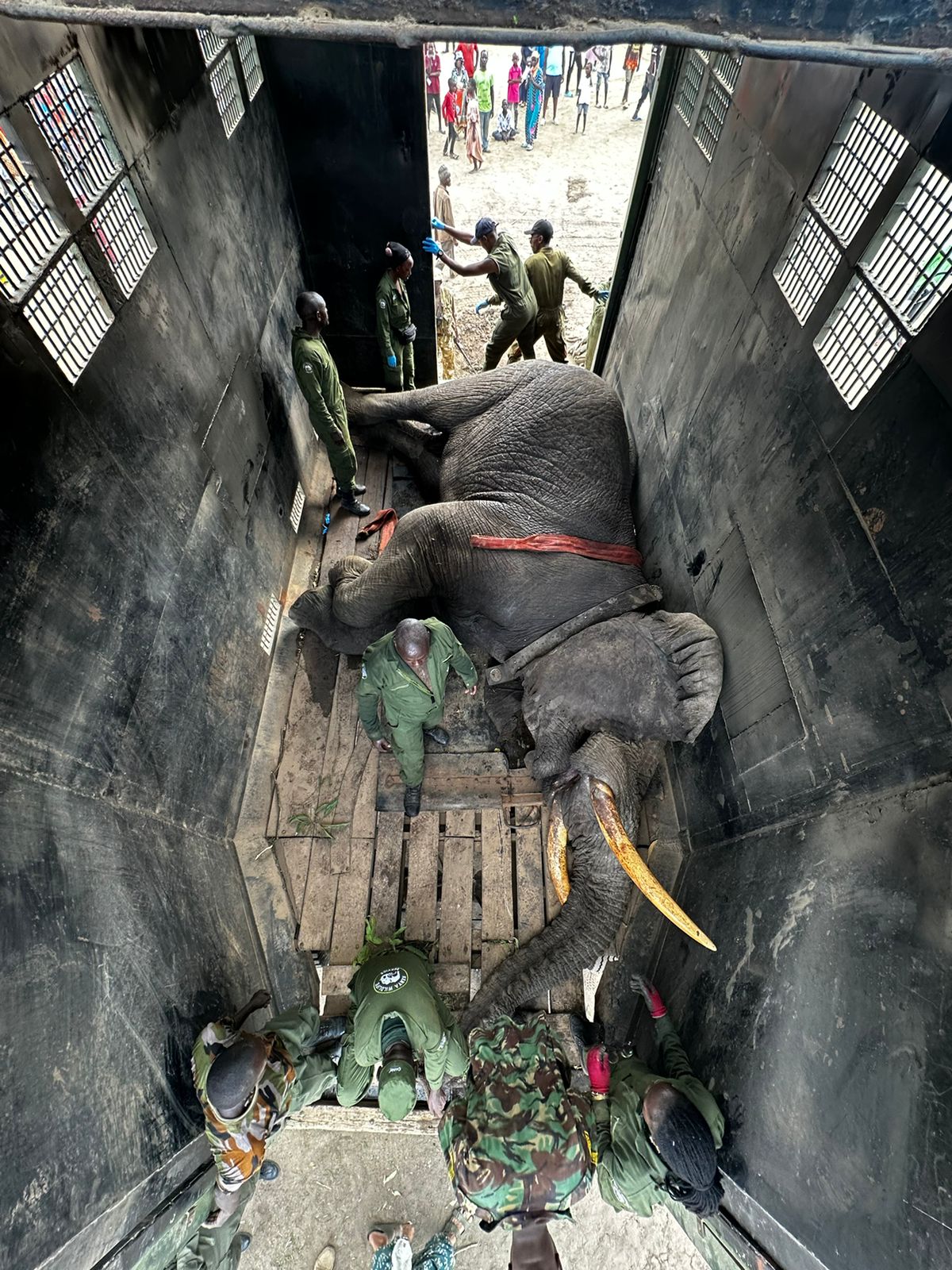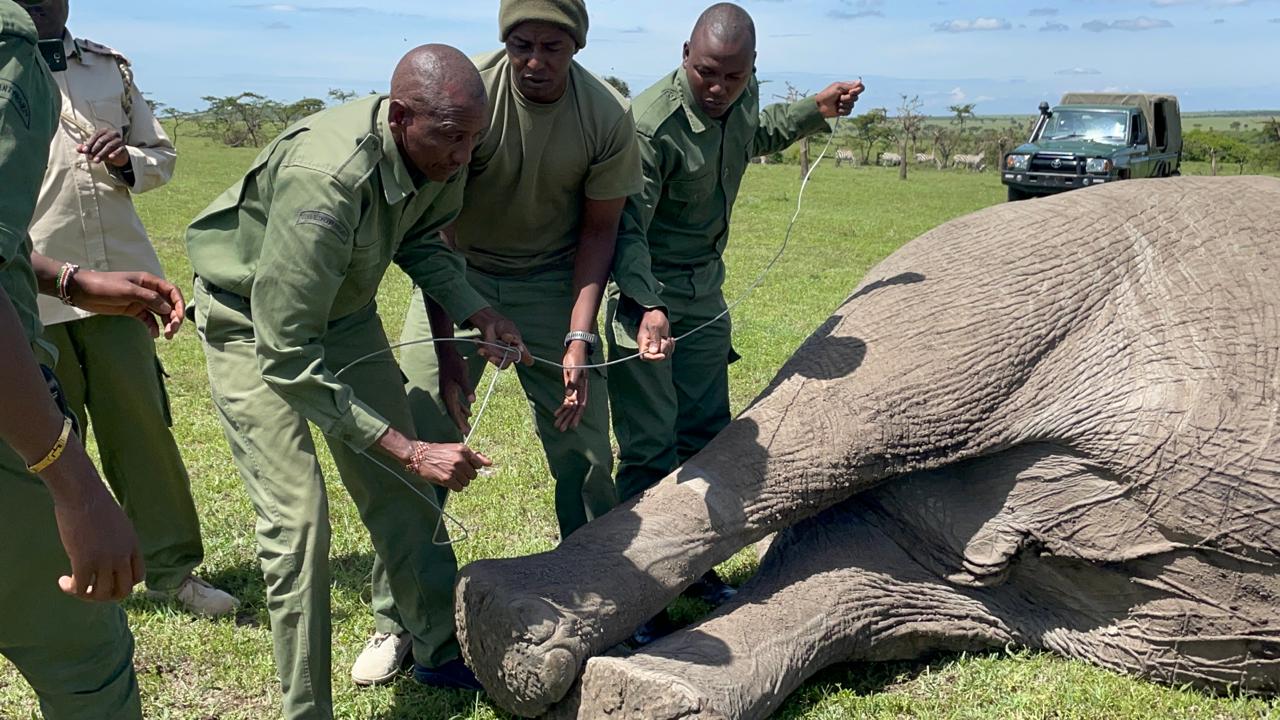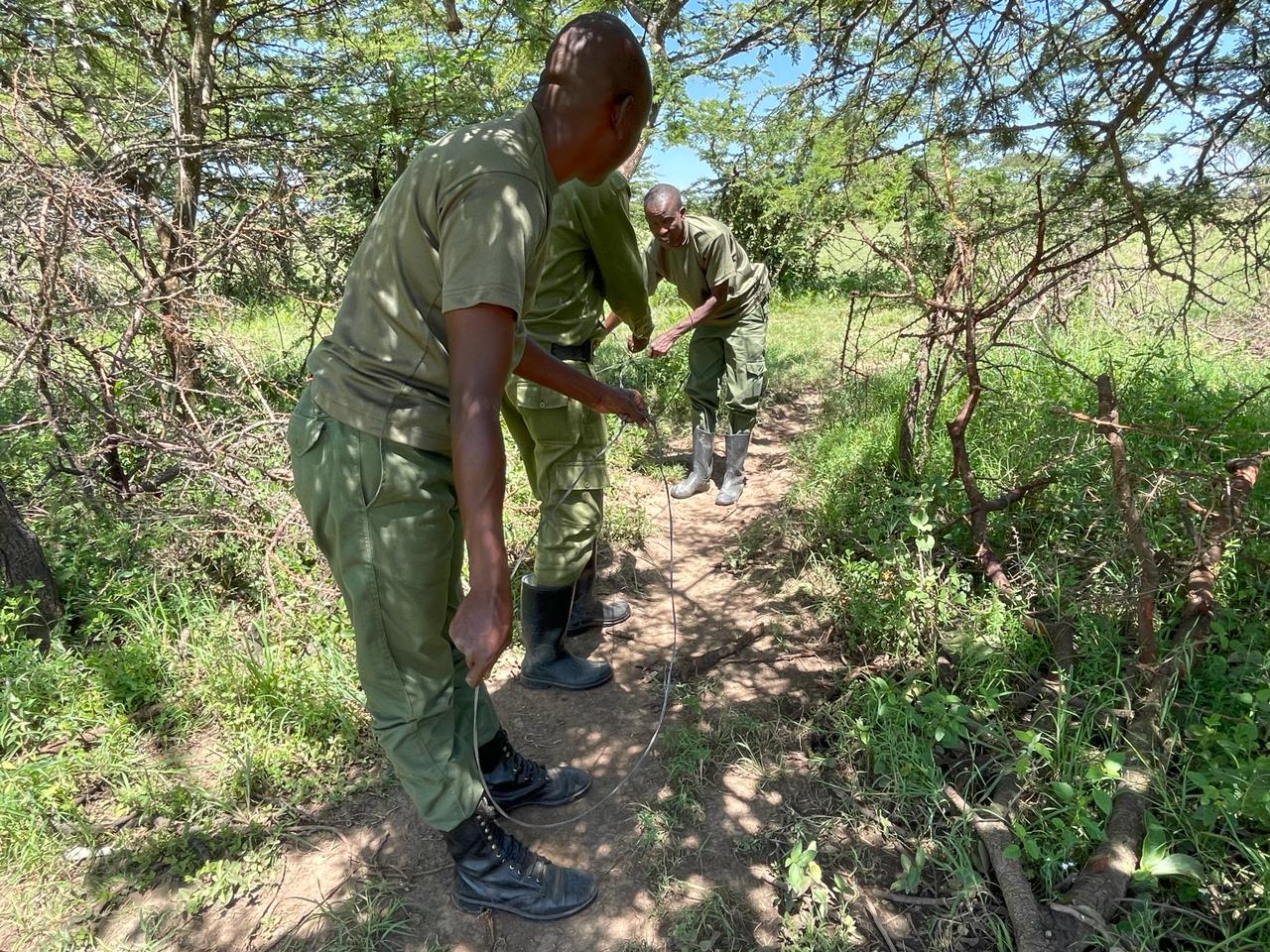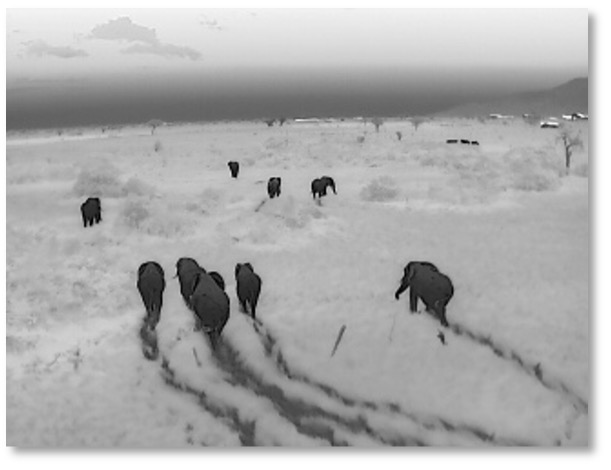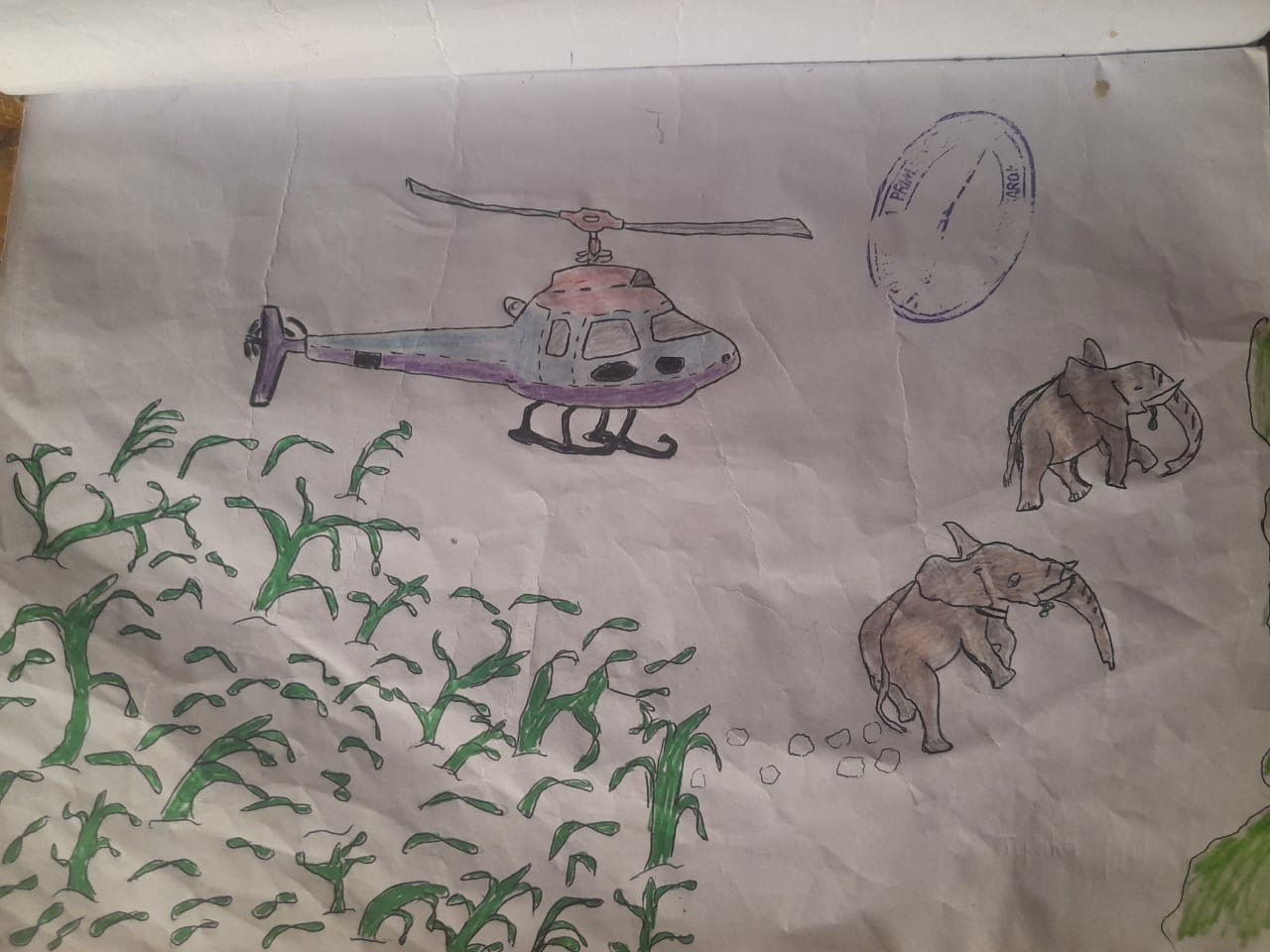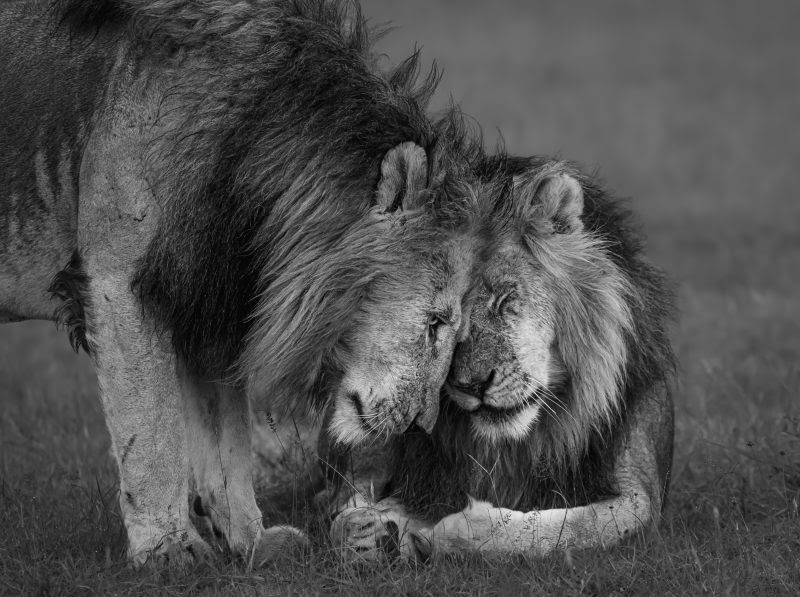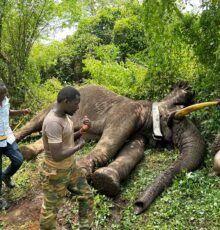 Bull elephant “Tino” was collared in early January by the the Wildlife Research and Training Institute (WRTI), Kenya Wildlife Service (KWS), and Mara Elephant Project to monitor his location in real-time as he was identified as a frequent crop raider in settlements along the Tana River. Just a week after his collaring, and thanks to the real time tracking, the MEP helicopter responded to an escalating conflict incident to move Tino out of a heavily developed area and his interactions with the community continued to escalate from there.
Bull elephant “Tino” was collared in early January by the the Wildlife Research and Training Institute (WRTI), Kenya Wildlife Service (KWS), and Mara Elephant Project to monitor his location in real-time as he was identified as a frequent crop raider in settlements along the Tana River. Just a week after his collaring, and thanks to the real time tracking, the MEP helicopter responded to an escalating conflict incident to move Tino out of a heavily developed area and his interactions with the community continued to escalate from there.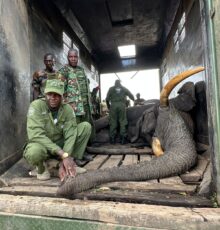 That’s why KWS mobilized their capture unit from Nairobi to translocate Tino to the Tsavo East National Park. MEP provided aerial assistance to the ground teams thanks to support from Rob Walker. Today, Tino remains in the protected Tsavo area and has resumed daily life without the frequent interactions with people.
That’s why KWS mobilized their capture unit from Nairobi to translocate Tino to the Tsavo East National Park. MEP provided aerial assistance to the ground teams thanks to support from Rob Walker. Today, Tino remains in the protected Tsavo area and has resumed daily life without the frequent interactions with people.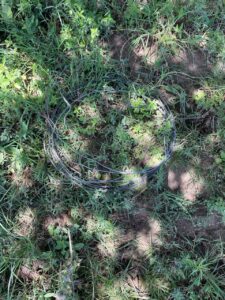 Anti-poaching activities remain a focus for MEP rangers. Since the pandemic, the demand for bushmeat has increased, and poachers use snares to injure and kill wildlife for bushmeat. In 2023, MEP rangers alongside our government partners removed the second highest number of snares in organizational history, and their efforts continue in 2024. In February, MEP rangers removed 35 snares in their various areas of operation, preventing further injury and death of wildlife and thwarting poacher’s attempts at consuming or selling bushmeat.
Anti-poaching activities remain a focus for MEP rangers. Since the pandemic, the demand for bushmeat has increased, and poachers use snares to injure and kill wildlife for bushmeat. In 2023, MEP rangers alongside our government partners removed the second highest number of snares in organizational history, and their efforts continue in 2024. In February, MEP rangers removed 35 snares in their various areas of operation, preventing further injury and death of wildlife and thwarting poacher’s attempts at consuming or selling bushmeat.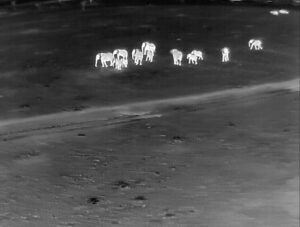 Farmers in the Mara are almost ready to harvest their short season crops, increasing the likelihood of conflict with elephants. In February, MEP rangers rapidly responded to conflict day and night using tools both old and new to help safely resolve these escalating incidents. The MEP Lima Team in Mosiro has been regularly monitoring elephants including Isiah, supported by the Royal African Foundation, and Gwen in the Rift Valley. They have been responding to increased conflict incidents as well.
Farmers in the Mara are almost ready to harvest their short season crops, increasing the likelihood of conflict with elephants. In February, MEP rangers rapidly responded to conflict day and night using tools both old and new to help safely resolve these escalating incidents. The MEP Lima Team in Mosiro has been regularly monitoring elephants including Isiah, supported by the Royal African Foundation, and Gwen in the Rift Valley. They have been responding to increased conflict incidents as well.
The “Golf” ranger team responded to conflict incidents with collared elephant Fitz, supported by the Angama Foundation, and his herd encroaching on farms at night. They successfully responded and pushed the herd out of maize farms in all cases.
The MEP mobile ranger team deployed the Elephant Cooperation drone to push four bull elephants out of a settlement area. The increase in fencing is disrupting landscape connectivity which results in more mitigation situations for MEP rangers, and drone continue to be a key tool for our rangers to rapidly move elephants out of fences and back to safety.
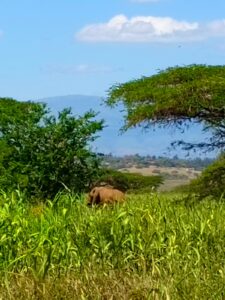 WRTI, KWS and MEP have tracked elephants in the Marmanet Forest after the first elephant, Vasco, moved from the Mau Forest to the Marmanet Forest alerting us to a security risk for elephants in the area. Since then, we’ve partnered on the ground to increase protection for the elephants in this forest including collared elephant Lolotoo. Collared in February 2022, this big bull, moves between the forest and Leakey’s Farm southwest of the forest bringing him close to settlements. In February, the team of rangers and scouts overseen by MEP used his movements to intervene protecting both Lolotoo and the community as he navigates this complex landscape.
WRTI, KWS and MEP have tracked elephants in the Marmanet Forest after the first elephant, Vasco, moved from the Mau Forest to the Marmanet Forest alerting us to a security risk for elephants in the area. Since then, we’ve partnered on the ground to increase protection for the elephants in this forest including collared elephant Lolotoo. Collared in February 2022, this big bull, moves between the forest and Leakey’s Farm southwest of the forest bringing him close to settlements. In February, the team of rangers and scouts overseen by MEP used his movements to intervene protecting both Lolotoo and the community as he navigates this complex landscape.
Overall, in February, MEP rangers alongside government partners arrested five habitat destruction suspects, confiscated 18 pieces of timber, 20 posts, destroyed three charcoal kilns, mitigated 17 conflict incidents and covered 1,631 km on foot patrol and 7,989 km by vehicle in GME.
 Finally, MEP rangers and researchers take their roles as ambassadors within the communities very seriously. They are not just ambassadors for wildlife, or habitat, but they embody the idea that you can make a living working in a field that ignites your passion. In February, the MEP long-term monitoring (LTM) team visited three Mara schools to present on their elephant monitoring and identification work and, most importantly, the vital role youth play in the future of the Mara’s wildlife and wild spaces. The 250 students from Sekenani and Ololchurra schools and the Semadep Foundation’s school were enthusiastic learners, and the MEP team was bolstered by their time spent with the next generation of Kenyan conservationists.
Finally, MEP rangers and researchers take their roles as ambassadors within the communities very seriously. They are not just ambassadors for wildlife, or habitat, but they embody the idea that you can make a living working in a field that ignites your passion. In February, the MEP long-term monitoring (LTM) team visited three Mara schools to present on their elephant monitoring and identification work and, most importantly, the vital role youth play in the future of the Mara’s wildlife and wild spaces. The 250 students from Sekenani and Ololchurra schools and the Semadep Foundation’s school were enthusiastic learners, and the MEP team was bolstered by their time spent with the next generation of Kenyan conservationists.
The final month ever of the Greatest Maasai Mara photo competition was February. After several years of running this amazing competition to benefit conservation, the Angama Foundation is discontinuing it. We are extremely grateful to all of the photographers over the years that have supported MEP with their talents.
A February entry by Chags Photography.
